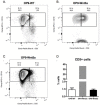B-1 cells and B-1 cell precursors prompt different responses to Wnt signaling
- PMID: 29928002
- PMCID: PMC6013157
- DOI: 10.1371/journal.pone.0199332
B-1 cells and B-1 cell precursors prompt different responses to Wnt signaling
Abstract
Recently several studies demonstrated a role for the Wnt pathway in lymphocyte development and self-renewal of hematopoietic stem cells (HSCs). B-1 cells constitute a separate lineage of B lymphocytes, originating during fetal hematopoiesis, expressing lymphoid and myeloid markers and possessing self-renewal ability, similar to early hematopoietic progenitors and HSCs. A plethora of studies have shown an important role for the evolutionary conserved Wnt pathway in the biology of HSCs and T lymphocyte development. Our previous data demonstrated abundant expression of Wnt pathway components by B-1 cells, including Wnt ligands and receptors. Here we report that the canonical Wnt pathway is activated in B-1 cell precursors, but not in mature B-1 cells. However, both B-1 precursors and B-1 cells are able to respond to Wnt ligands in vitro. Canonical Wnt activity promotes proliferation of B-1 cells, while non-canonical Wnt signals induce the expansion of B-1 precursors. Interestingly, using a co-culture system with OP9 cells, Wnt3a stimulus supported the generation of B-1a cells. Taking together, these results indicate that B-1 cells and their progenitors are differentially responsive to Wnt ligands, and that the balance of activation of canonical and non-canonical Wnt signaling may regulate the maintenance and differentiation of different B-1 cell subsets.
Conflict of interest statement
The authors have declared that no competing interests exist.
Figures







Similar articles
-
Wnt expression and canonical Wnt signaling in human bone marrow B lymphopoiesis.BMC Immunol. 2006 Jun 29;7:13. doi: 10.1186/1471-2172-7-13. BMC Immunol. 2006. PMID: 16808837 Free PMC article.
-
Flt3 ligand supports the differentiation of early B cell progenitors in the presence of interleukin-11 and interleukin-7.Eur J Immunol. 1996 Jul;26(7):1504-10. doi: 10.1002/eji.1830260715. Eur J Immunol. 1996. PMID: 8766553
-
Contrasting responses of lymphoid progenitors to canonical and noncanonical Wnt signals.J Immunol. 2008 Sep 15;181(6):3955-64. doi: 10.4049/jimmunol.181.6.3955. J Immunol. 2008. PMID: 18768850 Free PMC article.
-
Hematopoietic stem cell fate decisions are regulated by Wnt antagonists: comparisons and current controversies.Exp Hematol. 2013 Jan;41(1):3-16. doi: 10.1016/j.exphem.2012.09.006. Epub 2012 Sep 25. Exp Hematol. 2013. PMID: 23022129 Review.
-
Non-canonical Wnt signaling pathways in hematopoiesis.Immunol Res. 2010 Mar;46(1-3):155-64. doi: 10.1007/s12026-009-8116-7. Immunol Res. 2010. PMID: 19763894 Review.
Cited by
-
The pancancer landscape of Wnt family expression reveals potential biomarkers in urinary system tumors.Cancer Gene Ther. 2021 Sep;28(9):1035-1045. doi: 10.1038/s41417-020-00273-6. Epub 2020 Dec 11. Cancer Gene Ther. 2021. PMID: 33311568
-
Cryptolepine Suppresses Colorectal Cancer Cell Proliferation, Stemness, and Metastatic Processes by Inhibiting WNT/β-Catenin Signaling.Pharmaceuticals (Basel). 2023 Jul 19;16(7):1026. doi: 10.3390/ph16071026. Pharmaceuticals (Basel). 2023. PMID: 37513937 Free PMC article.
-
Validation and analysis of expression, prognosis and immune infiltration of WNT gene family in non-small cell lung cancer.Front Oncol. 2022 Jul 25;12:911316. doi: 10.3389/fonc.2022.911316. eCollection 2022. Front Oncol. 2022. PMID: 35957916 Free PMC article.
-
Wnt Signaling and Its Significance Within the Tumor Microenvironment: Novel Therapeutic Insights.Front Immunol. 2019 Dec 16;10:2872. doi: 10.3389/fimmu.2019.02872. eCollection 2019. Front Immunol. 2019. PMID: 31921137 Free PMC article. Review.
-
Identification of molecular mechanism and key biomarkers in membranous nephropathy by bioinformatics analysis.Am J Transl Res. 2022 Aug 15;14(8):5833-5847. eCollection 2022. Am J Transl Res. 2022. PMID: 36105034 Free PMC article.
References
-
- Montecino-Rodriguez E, Leathers H, Dorshkind K. Identification of a B-1 B cell-specified progenitor. Nat Immunol. 2006;7(3):293–301. Epub 2006/01/24. doi: 10.1038/ni1301 . - DOI - PubMed
-
- Dorshkind K, Montecino-Rodriguez E. Fetal B-cell lymphopoiesis and the emergence of B-1-cell potential. Nat Rev Immunol. 2007;7(3):213–9. doi: 10.1038/nri2019 . - DOI - PubMed
-
- Yoshimoto M, Montecino-Rodriguez E, Ferkowicz MJ, Porayette P, Shelley WC, Conway SJ, et al. Embryonic day 9 yolk sac and intra-embryonic hemogenic endothelium independently generate a B-1 and marginal zone progenitor lacking B-2 potential. Proc Natl Acad Sci U S A. 2011;108(4):1468–73. doi: 10.1073/pnas.1015841108 ; PubMed Central PMCID: PMCPMC3029764. - DOI - PMC - PubMed
-
- Montecino-Rodriguez E, Dorshkind K. B-1 B cell development in the fetus and adult. Immunity. 2012;36(1):13–21. doi: 10.1016/j.immuni.2011.11.017 ; PubMed Central PMCID: PMCPMC3269035. - DOI - PMC - PubMed
-
- Kantor AB, Herzenberg LA. Origin of murine B cell lineages. Annual review of immunology. 1993;11:501–38. Epub 1993/01/01. doi: 10.1146/annurev.iy.11.040193.002441 . - DOI - PubMed
Publication types
MeSH terms
Substances
LinkOut - more resources
Full Text Sources
Other Literature Sources
Medical
Molecular Biology Databases

